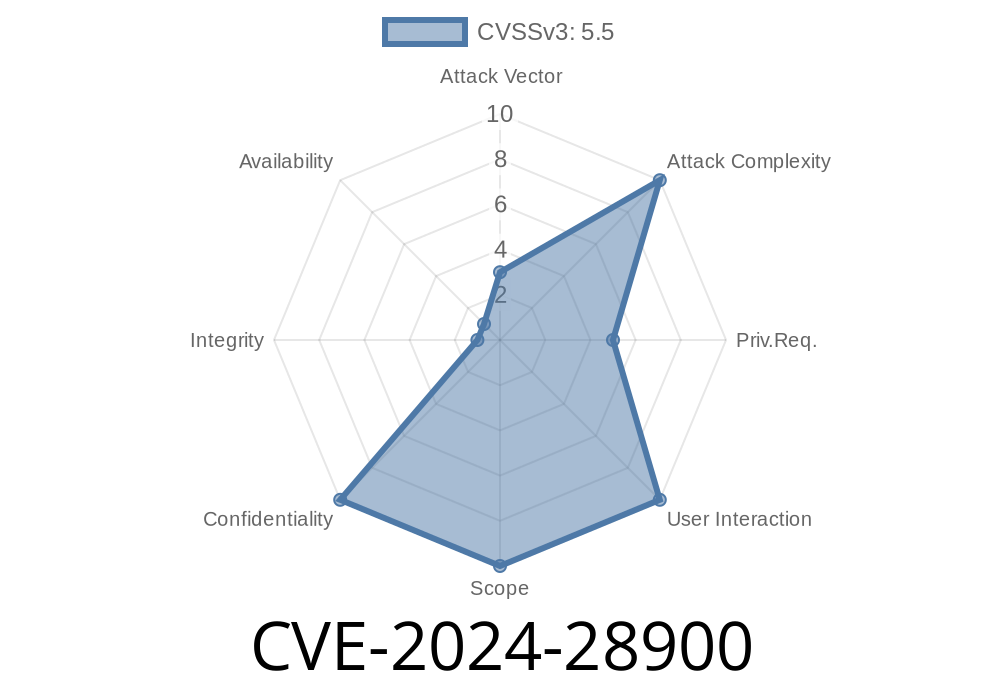CVE-2024-28900 - Understanding the Windows Remote Access Connection Manager Information Disclosure Vulnerability and How to Mitigate It

The Windows operating system has always been heavily utilized by businesses and homes around the world, and like any software, it has vulnerabilities that can endanger sensitive information. One such vulnerability found in the Windows Remote Access Connection Manager triggers an information disclosure vulnerability (CVE-2024-28900) that could be exploited by attackers to access critical information on affected systems.
In this long read post, we will analyze the details of this vulnerability, provide code snippets to help understand the threat better, provide links to original references, and lastly, suggest ways to mitigate the CVE-2024-28900 vulnerability effectively.
What is CVE-2024-28900?
CVE-2024-28900 is a vulnerability that affects the Windows Remote Access Connection Manager (RASMAN) service, which manages connections via the Remote Access Server (RAS) protocols. The vulnerability specifically targets the way RASMAN handles objects in the memory. Faulty processing of this could allow attackers to access unauthorized data on the targeted system remotely.
This vulnerability can pose a significant risk to users, especially when attackers exploit the compromised information to infiltrate further into the network.
Technical Details
The flaw in RASMAN is caused mainly by insufficient validation of user-supplied input, leading to a type of attack known as an out-of-bounds read or memory corruption issue. Here's a simplified pseudocode example of the vulnerable code snippet:
function processRASMAN_request(request) {
let buffer = alloc_buffer(request.length);
memcpy(buffer, request.data, request.length);
let object = parse_request(buffer);
validate_object(object); // MISSING VALIDATION!
let response = process_request(object);
send(response);
}
As seen in the code snippet, the validate_object() function is missing, which results in an insufficient validation process of the data supplied by the user or attacker.
Exploit Details
An attacker with low-level privileges on the target system can exploit this vulnerability by providing a specially crafted input that triggers the out-of-bounds read. This would result in unauthorized disclosure of information and possibly even allow the attacker to execute arbitrary code.
An example of a potential exploit code could look like this
import socket
# Change TARGET_HOST and TARGET_PORT to actual values
TARGET_HOST = "example.com"
TARGET_PORT = 12345
# Craft a malicious RASMAN request
bad_request = b"\x01" * 100
sock = socket.socket(socket.AF_INET, socket.SOCK_STREAM)
sock.connect((TARGET_HOST, TARGET_PORT))
# Sending malicious request
sock.send(bad_request)
Such a script, when executed, would send an ill-formed request specifically designed to exploit the vulnerability and open the door to accessing sensitive data.
Original References
A detailed explanation and mitigation steps for this vulnerability are provided by the following official sources:
1. CVE-2024-28900 - NIST National Vulnerability Database
2. Microsoft Security Advisory
Mitigation Steps
Microsoft has released patches to address this vulnerability. Users should update their systems as soon as possible and should always ensure that they keep their operating systems up to date.
Moreover, it is recommended to restrict low-level access to privileged functionality and monitor any unusual activity on the network for possible exploitation attempts.
Conclusion
Windows Remote Access Connection Manager Information Disclosure Vulnerability (CVE-2024-28900) highlights the importance of keeping software updated and validated. As cybercriminals continue to uncover and exploit vulnerabilities like these, it becomes imperative for users and administrators alike to ensure that their systems are operating in the most secure manner possible. Keeping software up to date, validating communications, and being vigilant for unexpected network activity can go a long way in safeguarding the system and sensitive information.
Timeline
Published on: 04/09/2024 17:15:48 UTC
Last modified on: 04/10/2024 13:24:00 UTC